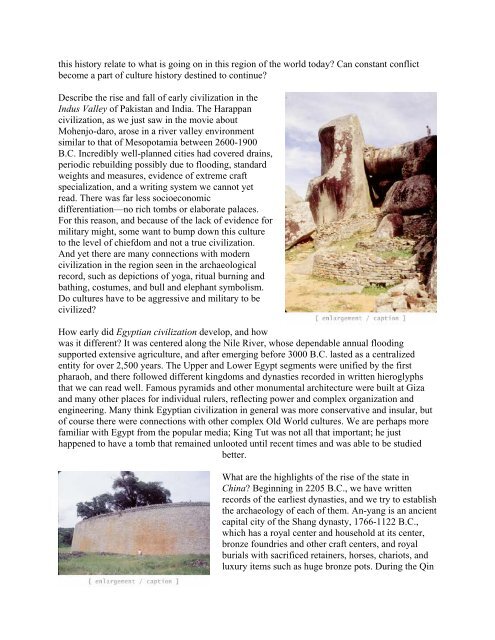INTRODUCTION TO ARCHAEOLOGY Nancy White - Touro Institute
INTRODUCTION TO ARCHAEOLOGY Nancy White - Touro Institute
INTRODUCTION TO ARCHAEOLOGY Nancy White - Touro Institute
Create successful ePaper yourself
Turn your PDF publications into a flip-book with our unique Google optimized e-Paper software.
this history relate to what is going on in this region of the world today? Can constant conflict<br />
become a part of culture history destined to continue?<br />
Describe the rise and fall of early civilization in the<br />
Indus Valley of Pakistan and India. The Harappan<br />
civilization, as we just saw in the movie about<br />
Mohenjo-daro, arose in a river valley environment<br />
similar to that of Mesopotamia between 2600-1900<br />
B.C. Incredibly well-planned cities had covered drains,<br />
periodic rebuilding possibly due to flooding, standard<br />
weights and measures, evidence of extreme craft<br />
specialization, and a writing system we cannot yet<br />
read. There was far less socioeconomic<br />
differentiation—no rich tombs or elaborate palaces.<br />
For this reason, and because of the lack of evidence for<br />
military might, some want to bump down this culture<br />
to the level of chiefdom and not a true civilization.<br />
And yet there are many connections with modern<br />
civilization in the region seen in the archaeological<br />
record, such as depictions of yoga, ritual burning and<br />
bathing, costumes, and bull and elephant symbolism.<br />
Do cultures have to be aggressive and military to be<br />
civilized?<br />
How early did Egyptian civilization develop, and how<br />
was it different? It was centered along the Nile River, whose dependable annual flooding<br />
supported extensive agriculture, and after emerging before 3000 B.C. lasted as a centralized<br />
entity for over 2,500 years. The Upper and Lower Egypt segments were unified by the first<br />
pharaoh, and there followed different kingdoms and dynasties recorded in written hieroglyphs<br />
that we can read well. Famous pyramids and other monumental architecture were built at Giza<br />
and many other places for individual rulers, reflecting power and complex organization and<br />
engineering. Many think Egyptian civilization in general was more conservative and insular, but<br />
of course there were connections with other complex Old World cultures. We are perhaps more<br />
familiar with Egypt from the popular media; King Tut was not all that important; he just<br />
happened to have a tomb that remained unlooted until recent times and was able to be studied<br />
better.<br />
What are the highlights of the rise of the state in<br />
China? Beginning in 2205 B.C., we have written<br />
records of the earliest dynasties, and we try to establish<br />
the archaeology of each of them. An-yang is an ancient<br />
capital city of the Shang dynasty, 1766-1122 B.C.,<br />
which has a royal center and household at its center,<br />
bronze foundries and other craft centers, and royal<br />
burials with sacrificed retainers, horses, chariots,<br />
and<br />
luxury items such as huge bronze pots. During the Qin
















